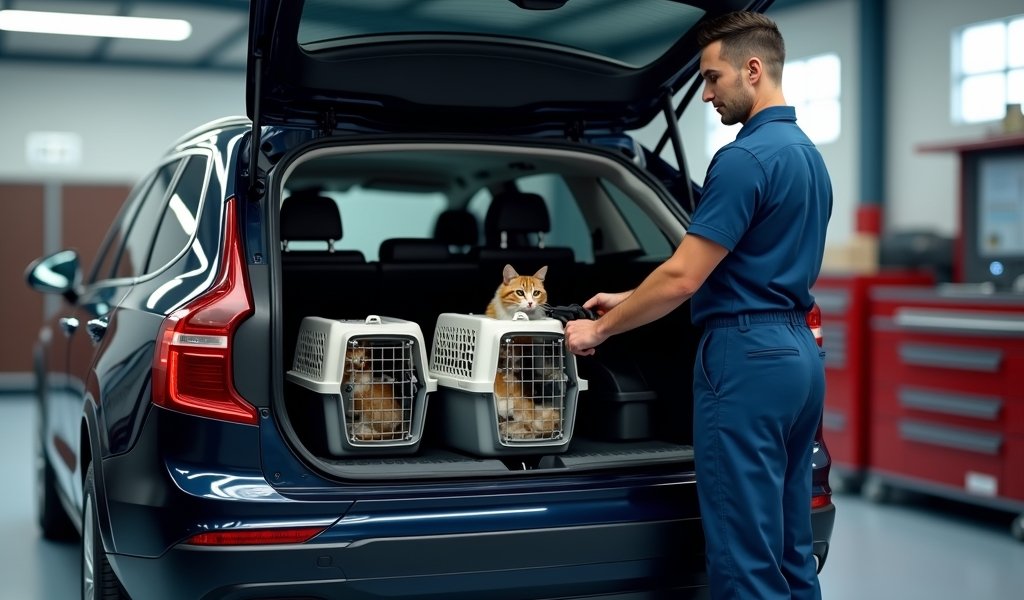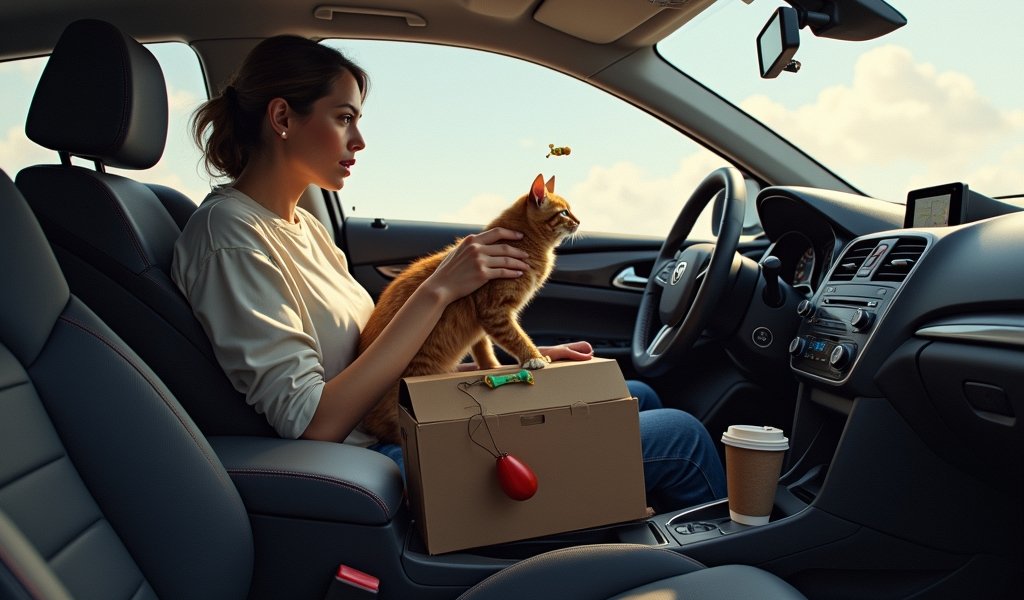Overview
This article compares three top cat carriers for car travel—the premium Sleepypod Mobile Pet Bed with 5-star crash safety, the budget-friendly Sherpa Deluxe, and the window-view PetSafe Happy Ride Booster Seat—while providing detailed advice on getting cats comfortable with carriers and ensuring safe road trips. It emphasizes that proper carriers are essential for feline safety during travel, not just convenience, and includes techniques for reducing carrier anxiety through gradual acclimation and positive associations.
Table of Contents
- Introduction
- What to Look for in a Cat Travel Carrier for Car
- Best Pick #1: Sleepypod Mobile Pet Bed
- Best Pick #2: Sherpa Deluxe Pet Carrier
- Best Pick #3: PetSafe Happy Ride Booster Seat
- Tips for Getting Your Cat Comfortable
- Road Trip Advice: Traveling Safely With Your Cat
- Conclusion
- Frequently Asked Questions
Introduction
If you’ve ever tried to transport your feline friend in an ordinary cardboard box or that ancient carrier collecting dust in your garage, you already know the drama that unfolds. Trust me, I’ve been there – claw marks, escape attempts, and that pitiful meowing that makes you feel like the worst pet parent ever.
After years of working with vehicle configurations and pet safety equipment, I can tell you that a proper cat travel carrier for car journeys isn’t just a nice-to-have – it’s essential. Not only for your sanity but for your cat’s safety and well-being during travel.
Unlike humans who have seatbelts, airbags, and an understanding of vehicle movement, our cats need specialized equipment to keep them secure during sudden stops or, heaven forbid, accidents. A proper carrier also gives your nervous kitty a safe space during the stress of travel.
In this guide, I’ll walk you through the three best cat carriers specifically designed for car travel. I’ve tested dozens over the years, and these stand out for their safety features, comfort, and practicality. Whether you’re heading to the vet or embarking on a cross-country road trip, these carriers will make the journey smoother for everyone involved.
What to Look for in a Cat Travel Carrier for Car
Before we dive into specific products, let’s talk about what separates an average carrier from one that’s truly designed for car safety. After all, not all carriers are created equal, especially when it comes to vehicle travel.
Safety Features
The primary purpose of a cat carrier is to keep your pet safe during travel. Look for carriers with robust crash-testing certification from organizations like the Center for Pet Safety. Solid construction with impact-resistant materials is non-negotiable for car travel.
Secure Attachment Points
A quality carrier should have dedicated straps or openings that allow you to thread your car’s seatbelt through, securing the carrier firmly to the seat. Some premium models even integrate with your car’s LATCH system (the same anchors used for child car seats).
Adequate Ventilation
Cats can overheat quickly, so proper airflow is essential. Look for multiple mesh panels that provide cross-ventilation, regardless of how the carrier is positioned in your vehicle.
Comfort Features
A comfortable cat is a quieter, less stressed cat. Padded floors, soft interior lining, and enough space for your cat to turn around and lie down will make the journey more pleasant for everyone.
Easy Access Design
When you’re juggling car keys, a nervous cat, and maybe a coffee, you need a carrier that doesn’t require three hands to operate. Top-loading designs or carriers with multiple entry points make loading your reluctant traveler much easier.
Durability
Car carriers take more abuse than home carriers. They get jostled, bumped, and sometimes subjected to temperature extremes. High-quality materials, reinforced stitching, and sturdy hardware are worth the investment.

Best Pick #1: Sleepypod Mobile Pet Bed
If carriers were luxury vehicles, the Sleepypod would be a Rolls-Royce. It’s not just a carrier; it’s an engineering marvel designed specifically with car safety in mind.
Key Features
- Dimensions: 17″ diameter x 13.5″ height (accommodates cats up to 15 pounds)
- 5-star crash test rating from the Center for Pet Safety
- PPRS (Pet Passenger Restraint System) that integrates with your car’s seatbelt
- Plush, machine-washable interior bedding
- Removable dome top that converts carrier to bed
What makes the Sleepypod stand out is its dual functionality. At home, it serves as a cozy bed that your cat can enjoy daily. When it’s time to travel, simply zip on the mesh dome top, and your cat’s familiar sleeping spot transforms into a secure travel carrier. This familiarity dramatically reduces travel anxiety for most cats.
The safety features are unparalleled. The Sleepypod’s unique design allows your car’s seatbelt to secure it firmly in place, while the padded interior acts as a safety cocoon during sudden stops or impacts. In crash tests, it consistently outperforms other carriers, which is why veterinarians often recommend it despite the higher price point.
Pros and Cons
Pros:
- Best-in-class safety ratings
- Dual functionality reduces carrier anxiety
- Premium materials and construction
- Easy to clean with machine-washable bedding
Cons:
- Premium price ($150-200 range)
- Heavier than soft-sided alternatives (4.5 pounds empty)
- Round shape may not fit perfectly in all vehicle seats
The Sleepypod is ideal for cat parents who prioritize safety above all else and don’t mind investing in quality. It’s particularly valuable for cats with severe carrier anxiety since they can use it as a bed between travels. For longer road trips or frequent travelers, this carrier is worth every penny for the peace of mind it provides.
Best Pick #2: Sherpa Deluxe Pet Carrier
The Sherpa Deluxe hits the sweet spot between affordability and functionality. While not as safety-focused as the Sleepypod, it offers solid protection with thoughtful design features that make car travel practical.
Key Features
- Dimensions: 17″ L x 11″ W x 10.5″ H (medium size)
- Built-in seatbelt strap for secure attachment
- Mesh panels on three sides for ventilation
- Faux lambskin liner that’s machine washable
- Rear pocket for storing small items
- Approved for airline use (fits under most airplane seats)
What I appreciate about the Sherpa is its versatility. The patented spring wire frame allows the carrier to be compressed slightly to fit under airplane seats without compromising structural integrity. This makes it perfect for cat owners who travel by both car and plane.
While not independently crash-tested like the Sleepypod, the seatbelt strap does provide a secure attachment point to keep the carrier from becoming a projectile during sudden stops. The reinforced bottom also helps maintain the carrier’s shape even when your cat shifts position.
Pros and Cons
Pros:
- Excellent value for the price ($40-60 range)
- Lightweight (about 3 pounds empty)
- Multiple carrying options (handles and shoulder strap)
- Fits well on most vehicle seats
Cons:
- Less crash protection than hard-sided carriers
- Soft sides may collapse if not properly supported
- Zipper quality isn’t as durable as premium options
The Sherpa Deluxe is perfect for cat owners on a budget who still want quality construction and thoughtful design. It’s also ideal for multi-modal travel where you might need to transition from car to airplane. This carrier offers a practical balance of features that works well for most routine trips like vet visits or weekend getaways.
Best Pick #3: PetSafe Happy Ride Booster Seat
The PetSafe Happy Ride takes a completely different approach to cat car travel. Instead of enclosing your cat completely, it functions as an elevated car seat with restraint features to keep your cat secure while allowing them to see out the window.
Key Features
- Dimensions: 16″ L x 13″ W x 9″ H (medium size)
- Elevated design that allows visibility out windows
- Attaches to car seat with adjustable straps
- Includes safety tether that connects to harness
- Quilted exterior with cozy fleece lining
- Folds flat for storage
This carrier is designed for the curious cat who gets anxious when they can’t see what’s happening. The basket-like design elevates your pet to window level, allowing them to watch the scenery pass by. This visual stimulation can significantly reduce anxiety in some cats.
Safety-wise, it’s important to note this option requires your cat to wear a proper harness, as the integrated safety tether attaches to the harness rather than enclosing your cat completely. This makes it best suited for calm, well-behaved cats who won’t try to escape but still need secure restraint.
Pros and Cons
Pros:
- Provides visibility that reduces anxiety for some cats
- Comfortable padded interior
- Secure attachment to vehicle seat
- Space-saving design when not in use
Cons:
- Less protection than fully-enclosed carriers
- Requires your cat to wear a harness
- Not suitable for nervous or escape-prone cats
The PetSafe Happy Ride is perfect for confident cats who enjoy watching the world go by. It’s ideal for shorter trips where your cat remains under supervision, and for cats who become more stressed when fully enclosed. Some pet car accessories like window shades can complement this carrier by preventing overheating while still allowing visibility.

Tips for Getting Your Cat Comfortable
Even the finest carrier won’t help if your cat refuses to get in it. After years of working with reluctant feline travelers, I’ve developed some tried-and-true methods to reduce carrier anxiety.
Start Early and Go Slow
Begin carrier acclimation at least 2-3 weeks before your planned trip. Place the carrier in a common area with the door removed or secured open. This allows your cat to investigate on their own terms without feeling trapped.
Gradually progress through these steps:
- Place treats and toys inside the carrier randomly throughout the day
- Feed meals inside or near the carrier
- Practice short closures (5-10 seconds) while offering treats
- Gradually increase closure time as your cat remains calm
Create Positive Associations
Cats form strong associations between experiences and locations. If the carrier only appears before stressful vet visits, of course they’ll hate it! Make the carrier a positive space by:
- Spraying with Feliway pheromone spray 15 minutes before use (never spray with cat inside)
- Placing a piece of your worn clothing inside for familiar scent
- Adding catnip or silvervine for cats who respond positively to these herbs
- Using the carrier for “trips” to positive destinations (like a different room for special treats)
The Right Loading Technique
How you put your cat into the carrier matters enormously. For top-loading carriers, lower your cat in hindquarters first, supporting their chest and front legs. For front-loading models, try these approaches:
- Wrap your cat in a towel before gently placing them inside
- Tilt the carrier so the door faces upward, lower cat in, then gently rotate carrier to normal position
- For very resistant cats, try backing them into the carrier so they walk in rear-first
Never force a terrified cat into a carrier—this only reinforces negative associations. If your cat is extremely resistant despite acclimation attempts, consult your veterinarian about short-term anti-anxiety medications for travel days.
Road Trip Advice: Traveling Safely With Your Cat
Once your cat is securely in their carrier and properly fastened in your vehicle, the journey begins. Here are some mechanic’s tips for a smooth ride:
Secure Placement in Vehicle
The safest place for your cat’s carrier is on the floor behind the front passenger seat. This provides the most protection during sudden stops. If using a seat-mounted carrier, the back seat is preferable to the front (where airbags could cause injury).
Always secure the carrier according to manufacturer instructions—usually with a seatbelt threaded through designated loops or straps. Never place the carrier in the front seat or cargo area where it could become a dangerous projectile during sudden stops.
Climate Control Considerations
Cats are sensitive to temperature extremes. Maintain cabin temperature between 68-75°F for optimal comfort. When using car seat covers for pets, ensure they don’t block ventilation to the carrier.
Never leave your cat unattended in a parked vehicle, even with windows cracked. Interior temperatures can rise to dangerous levels within minutes, even on mild days. If you must stop, take your cat with you or have someone stay with them in the running vehicle.
Managing Motion Sickness
Some cats experience motion sickness during car travel. Signs include excessive drooling, vomiting, or unusual lethargy. To minimize these issues:
- Withhold food for 2-3 hours before travel (but never restrict water)
- Keep the carrier stable and minimize movement
- Maintain good air circulation without direct cold air blasting the carrier
- Consider veterinarian-prescribed motion sickness medication for severely affected cats
Rest Stop Protocol
For longer journeys, plan rest stops every 2-3 hours. Park in quiet areas away from traffic noise and offer water while your cat remains in the carrier. For extended trips, a portable litter box in the car can be helpful, but most cats will “hold it” for 8-10 hours if necessary.
Never open the carrier while in transit or in unsecured areas. If your cat needs to stretch, only allow this in a closed vehicle with doors locked and windows up. Even better-behaved cats can become frightened and bolt in unfamiliar environments.
Conclusion
Choosing the right cat travel carrier for car journeys isn’t just about convenience—it’s about creating a safe, low-stress experience for your feline companion. After testing countless options over the years, the Sleepypod Mobile Pet Bed stands out for unparalleled safety, the Sherpa Deluxe offers excellent value for everyday use, and the PetSafe Happy Ride provides a unique solution for curious cats who hate confinement.
Remember that the best carrier is the one that works for your specific cat’s temperament and your travel needs. Whichever you choose, take time to properly acclimate your cat to their carrier well before your journey. This preparation, combined with the right equipment, makes all the difference between a stressful ordeal and a manageable trip.
With proper carrier selection, vehicle security, and attention to your cat’s comfort needs, you’ll be ready to hit the road with your feline friend safely by your side. Happy travels!
Frequently Asked Questions
How should I secure a cat carrier in my car?
Thread your vehicle’s seatbelt through the carrier’s designated security loops or use the carrier’s built-in straps to attach to the seatbelt. Place the carrier on the back seat or floor behind the front passenger seat, never in the front seat where airbags deploy.
What size carrier do I need for my cat?
Choose a carrier where your cat can stand up, turn around, and lie down comfortably. Measure your cat from nose to tail base and add 2-3 inches for length, then measure shoulder height and add 3-4 inches for height.
Can I use a dog carrier for my cat?
While dog carriers might work in a pinch, cat-specific carriers typically have smaller ventilation holes that prevent escape and features designed for feline comfort. Cats generally prefer slightly smaller, cozier spaces compared to dogs.
How do I get my cat to stop crying in the carrier?
Acclimate your cat by making the carrier a regular part of their environment, not just for travel. Use pheromone sprays, familiar bedding, and treats to create positive associations, and cover part of the carrier with a towel during travel to create a sense of security.
How long can a cat safely stay in a carrier?
Most cats can tolerate 6-8 hours in a properly-sized carrier with adequate ventilation. For longer trips, provide opportunities for water, stretching breaks in a secure area, and access to a portable litter box.

